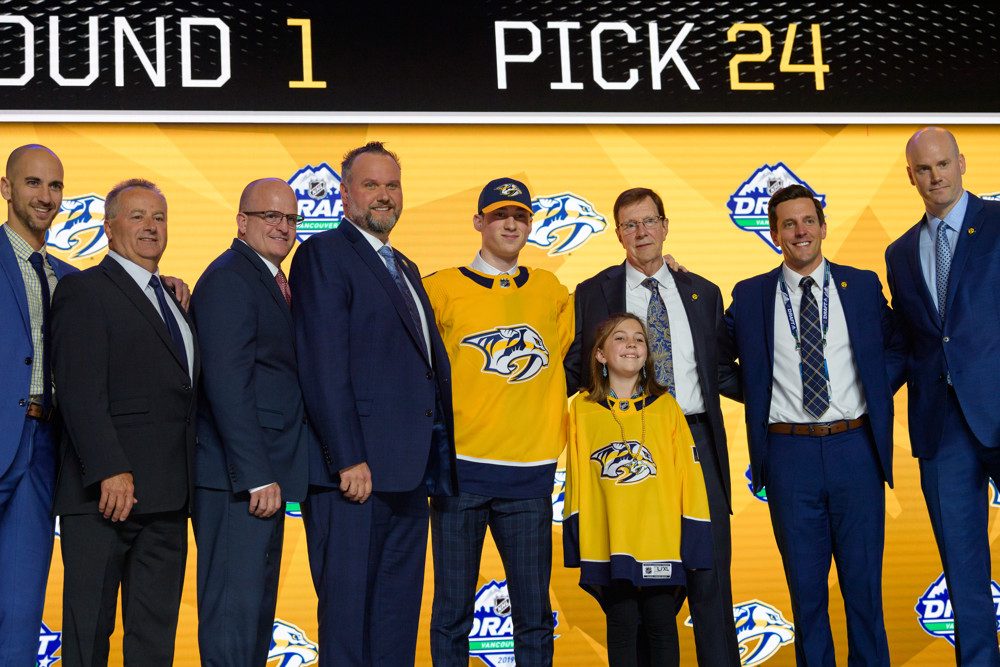Well… that happened, everyone take a deep breath. The “reset” that Nashville Predators GM David Poile teased a couple of weeks ago went into full swing through the NHL trade deadline. Poile (with an undeniable assist from incoming GM Barry Trotz) orchestrated four significant trades to move out veteran players with term remaining (Ekholm, Granlund, Niederreiter) and a pending restricted free agent on a down year (Jeannot) to return a bevy of future assets across the next three entry drafts. Starting this summer, Barry Trotz will have a lot of arrows in his quiver (29 draft picks in the next 3 years, 16 of which are in the first 3 rounds) to build the Predators’ roster in an image of his choosing. All those draft picks combined with a prospect pool deep in NHL-capable talent, a remaining set of veteran star players, and a whole bunch of available cap space create a scenario where the path forward for Barry Trotz could take a few different paths. With an eye on the future, let’s take a look at the ways the Predators roster could start taking shape this summer.
Everything Must Go!
The simplest option is to just stay on the path the Predators have started down. There are more veteran players who could have value to contending teams. Players like Colton Sissons, Ryan Johansen and Matt Duchene come to mind with possibly Juuse Saros if the Predators are really looking to tear it down to the studs. If it takes using a couple of picks to clear more salary (especially with term remaining), then it’s worth it but keep turning current players into future assets. Barry Trotz can then take all those picks and build a top-level prospect pool that gives the most chances possible to identify and develop star players. The challenge of this approach is that it relies largely on unknowns to build out the future core of the roster. Also, utilizing all those picks will make for a number of players that will never be signed as there won’t be enough contract slots for all of them.
Buy, Buy, Buy!
The polar opposite of the first option is to recognize that 29 draft picks are simply too many. Also if you operate from a place where you really can’t waste the final prime years of Josi, Duchene and Forsberg plus the final couple years of Saros’ affordable contract then instead of focusing on futures the goal would be to do a quick retool of the current roster by bringing in top-level talents via trade. Could Arizona be convinced to give up Clayton Keller? What about Columbus and Patrik Laine? With the number of teams currently over the salary cap using LTIR exceptions just to get through the season there could be plenty of options to bring in talent. The challenge of this approach, of course, is to not end up right where the Predators were before in the sticky middle without cap room to make changes. The quick retool would be high-level chaos but very short-sighted.
Diversify Your Portfolio
Another option is a bit of blending the first and second scenarios where it’s still a long-term view but combined with the recognition that 29 draft picks are too many. So the resulting option is to add as much top-level draft talent as possible by utilizing the second, third and fourth-round picks to collect as many picks from the top two rounds as possible. Having more opportunities at the earlier draft picks gives a generally greater likelihood of finding not only NHL contributors but potential star players. This option doesn’t necessarily accelerate the rebuild for the Nashville Predators but could make more effective use of all those draft picks.
An Offer (Sheet) You Can’t Refuse
Ah, offer sheets. The most fun transactional scenario that everyone loves to theorize about but almost never happens. And let’s be fair, I am no different. My own Twitter history is littered with calls for offer sheets on a laundry list of different players. Obviously, none of those happened but why not keep the tradition alive and come up with some others? As I noted just before the trade deadline, the Predators are in a unique position with all their picks that they can make a significant offer without seriously hampering their own ability to continue adding to the prospect pool (NOTE: offer sheet compensation must come from a team’s own picks, not those acquired by trade).
The important note here is that offer sheets really only work by targeting restricted free agents on cap-strapped teams. Using an offer sheet on a player whose rights are owned by a team with plenty of cap room is a pretty meaningless exercise (see: MTL offer sheet to Sebastian Aho) as it’s too easy for the team to match. So with that in mind, players like Trevor Zegras or Alex DeBrincat don’t make good targets unless you’re prepared to wildly overpay for them. Instead, I would look at a player like Gabriel Vilardi or Alex Newhook who are high-potential forwards where an overpay wouldn’t break the bank but could push the Kings and Avs respectively into a salary territory they can’t take on. While it’s still an unlikely approach, a building Predators team adding a player just reaching his prime years while maintaining future draft flexibility has got to be an attractive option. And incoming GM Barry Trotz being a first timer may loosen up the reins of tradition that might have held back David Poile from such a move.
Closing Bell
At the end of the day, it is likely some combination of all these options that will define the early portion of Barry Trotz’s tenure at the helm of the Nashville Predators. Trades will be made, draft picks will be made, and we may even see a surprise or two involving a name we never saw coming. But it is definitely an exciting time to be following the Predators as they are set up to be a major player in the transaction world starting this summer. So stay tuned because this could be a whole lot of fun.

















